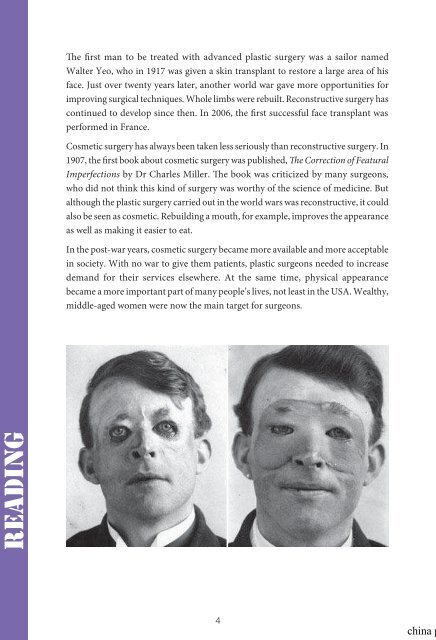plastic surgery - Duegemelle
plastic surgery - Duegemelle
plastic surgery - Duegemelle
You also want an ePaper? Increase the reach of your titles
YUMPU automatically turns print PDFs into web optimized ePapers that Google loves.
eaDiNg<br />
The first man to be treated with advanced <strong>plastic</strong> <strong>surgery</strong> was a sailor named<br />
Walter Yeo, who in 1917 was given a skin transplant to restore a large area of his<br />
face. Just over twenty years later, another world war gave more opportunities for<br />
improving surgical techniques. Whole limbs were rebuilt. Reconstructive <strong>surgery</strong> has<br />
continued to develop since then. In 2006, the first successful face transplant was<br />
performed in France.<br />
Cosmetic <strong>surgery</strong> has always been taken less seriously than reconstructive <strong>surgery</strong>. In<br />
1907, the first book about cosmetic <strong>surgery</strong> was published, The Correction of Featural<br />
Imperfections by Dr Charles Miller. The book was criticized by many surgeons,<br />
who did not think this kind of <strong>surgery</strong> was worthy of the science of medicine. But<br />
although the <strong>plastic</strong> <strong>surgery</strong> carried out in the world wars was reconstructive, it could<br />
also be seen as cosmetic. Rebuilding a mouth, for example, improves the appearance<br />
as well as making it easier to eat.<br />
In the post-war years, cosmetic <strong>surgery</strong> became more available and more acceptable<br />
in society. With no war to give them patients, <strong>plastic</strong> surgeons needed to increase<br />
demand for their services elsewhere. At the same time, physical appearance<br />
became a more important part of many people’s lives, not least in the USA. Wealthy,<br />
middle-aged women were now the main target for surgeons.<br />
Plastic <strong>surgery</strong> today<br />
Plastic <strong>surgery</strong> as we know it today began to take shape in the<br />
1960s and 1970s. Silicone, a fairly new substance in the medical<br />
world, was increasingly used. As a result, surgeons could perform<br />
a larger number of procedures. The popularity of cosmetic<br />
<strong>surgery</strong> meant that surgeons got more experience, and techniques<br />
were improved. This process continued throughout the rest of<br />
the 20th century.<br />
Today, <strong>plastic</strong> <strong>surgery</strong> continues to increase in popularity. In<br />
2010, over ten billion dollars was spent on cosmetic <strong>surgery</strong><br />
procedures in the USA alone. Breast enlargement was the most<br />
common procedure. Throughout the last fifty years, the USA<br />
has been the country where cosmetic <strong>surgery</strong> is most often<br />
performed and is most socially acceptable. Surveys have found<br />
that most Americans would not find it embarrassing to tell<br />
others if they had cosmetic <strong>surgery</strong>. In Sweden, one in four<br />
women under thirty said they would consider having <strong>surgery</strong> if<br />
it improved their appearance.<br />
Brazil has the most operations after the USA. More surprising<br />
perhaps, is that China is third on the list. The most popular<br />
operation amongst the Chinese is to make the eyes appear larger.<br />
The next most popular is to make the nose more prominent. In<br />
the West, the typical “nose job” aims to achieve the opposite effect.<br />
geNeral uNDerstaNDiNg<br />
Find the answers in the text.<br />
1. What is the text about?<br />
2. What do we learn about <strong>plastic</strong> <strong>surgery</strong> during the First<br />
World War?<br />
3. What does the text say about the difference between<br />
cosmetic and reconstructive <strong>plastic</strong> <strong>surgery</strong>?<br />
4. What do we learn about <strong>plastic</strong> <strong>surgery</strong> today?<br />
4 5<br />
china <strong>plastic</strong><br />
achieve uppnå<br />
available tillgänglig<br />
consider överväga, tänka<br />
sig<br />
demand efterfrågan<br />
elsewhere någon<br />
annanstans<br />
embarrassing genant<br />
experience erfarenhet<br />
improve förbättra<br />
increase öka<br />
limb lem, kroppsdel<br />
liposuction fettsugning<br />
opportunity möjlighet<br />
opposite motsatt<br />
post-war years<br />
efterkrigstiden<br />
procedure procedur,<br />
ingrepp<br />
prominent framträdande,<br />
utskjutande<br />
restore restaurera, laga<br />
substance ämne<br />
survey undersökning<br />
target mål<br />
wealthy välbärgad, rik<br />
worthy värdig


